Teens, adults and online health information
Beyond its role as an indispensable communications hub, internet access connects users to reams of vital information, necessary for life management, health and civic engagement. The section below explores the intersection of teen and adult data over time on health information searches, news-seeking behaviors and online purchasing.
Teens, adults and online health information
About a third (31%) of online teens ages 12 to 17 use the internet to look for health, dieting or physical fitness information, a finding that has remained relatively stable since the question was first asked in December 2000, when 26% of online teens gathered health information online. Older teens are more likely than younger teens to look online for health information (38% of teens ages 14-17 vs. 13% of teens ages 12-13). Back in 2000, when we first asked teens about their online health information seeking practices, teens showed similar variations – older teens, particularly older teen girls were more likely to look for health information online.
Teens also use the internet to look for information on health topics that are hard to talk about, like drug use, sexual health or depression. A bit more than one in six (17%) internet-using teens look online for information about sensitive health topics, statistically equivalent to the 22% who reported such searches in 2004.
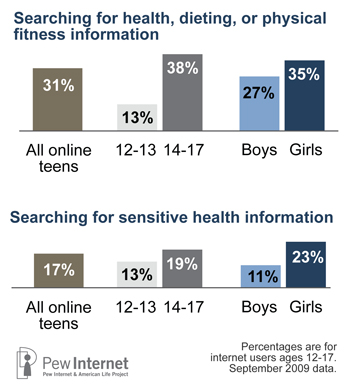
Girls are more likely than boys to look online for sensitive health information (23% vs. 11%). Younger boys are the least likely group to look for information on a health topic that is hard to talk about—just 4% of online boys ages 12-13 have done so, compared with 13% of older boys ages 14-17. Teens from the lowest- income families – those earning less than $30,000 annually – are the most likely to seek health information online. Just about a quarter (23%) of online low-income teens look for health information compared with 11% of teens from households earning more than $75,000 a year.
These patterns are similar to the differences visible between groups when we first asked about looking for sensitive health information in 2004. Back then, as now, girls, older teens and especially older girls were the most likely to look for sensitive health information online, as were lower income teens. In 2009, there are no racial or ethnic or education level differences in those who look for sensitive health information online compared with those who did not. However, in 2004, non-white teens and teens with less well-educated parents were more likely to look online for answers to health questions that were hard to ask of others.
A December 2008 Pew Internet survey of adults 18 and older indicates that overall, six in ten adults are online health information seekers.11 In that survey, adults were asked about a series of health topics, and 61% said they had looked online for at least one of those items.12 This is a notable increase over the 45% of all American adults who were looking online for health information in 2002. Specifically, in 2008, 38% of adults indicated that they look online for information about exercise or fitness, and 21% said they look online for information about depression, anxiety, stress or mental health issues. Overall, one quarter of adults (24%) report looking online for information about how to lose weight or how to control their weight. This is particularly common among adults in the 25-39 age range; four in ten adults in this population (40%) look online for information about weight control.
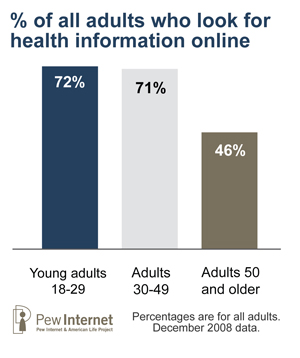
The key age divide among adult online health information seekers is 50 years of age. Seven in ten adults under age 50 are online health information seekers—72% of those under age 30 and 71% of those age 30-49. In comparison, just 46% of adults age 50 or older look for health information online. Overall, online women are more avid health information seekers than online men, and are significantly more likely than men to look for information about exercise and fitness (56% v. 48%), information about how to lose weight (42% v. 24%), and information about depression, anxiety and other mental health issues (35% v. 22%).
Trends in online purchasing
Nearly half (48%) of online teens buy things online like books, clothing or music, a practice that has been steadily increasing since the question was first asked in December 2000, when 31% of online teens made online purchases. Older teens ages 14-17 are more likely to buy items online – more than half (53%) of online teens in this age group have purchased items online, while 38% of middle school aged teens have made online purchases. Older girls drive this trend, with 57% of online girls ages 14-17 making online purchases while less than half (48%) of online boys the same age buy things online.
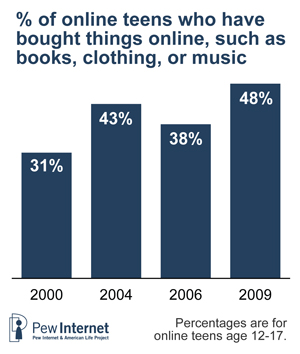
In both 2000 and 2009, teens living in households with higher incomes and education levels were consistently more likely to buy things online. The most striking differences between 2000 and today relate to gender. Older teens were and are more likely to buy online. However, older boys were the most likely online purchasers in 2000, while older girls lead the trend in 2009.
As one would expect, adults purchase goods online at a much higher rate than teens. As of April 2009, three in four online adults (75%) report purchasing a product online such as books, music, toys or clothing. That figure has increased at a fairly steady rate since Pew Internet first began asking this question in March 2000. At that time, about half of all online adults (48%) had ever purchased a product online.
Overall, white adult internet users are more likely to purchase products online than African American adult internet users (77% v. 60%), and educational attainment and income are both positively correlated with online shopping. More than eight in ten adult internet users (85%) living in households with annual incomes of $50,000 or more have purchased something online; that figure drops to 64% among internet users living in households with incomes below $50,000.
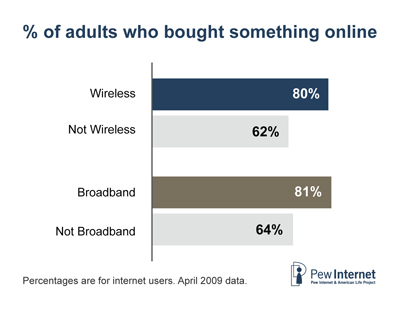
Other drivers of online shopping are wireless internet use and a broadband connection at home. Eight in ten wireless internet users (80%) have bought a product online, compared with just six in ten internet users who are not wireless (62%). Likewise, home broadband users are more likely than those without broadband at home (81% v. 64%) to be online shoppers.
Getting news online
About two-thirds (62%) of internet-using teens consume online news about current events and politics. These numbers have remained roughly the same since 2000, except for spikes around mid-term and general elections in our November 2004 and November 2006 studies, when news consumption rose to 76% and 77% of online teens, respectively. Older teens are more likely to visit sites for news or political information; 68% of online teens ages 14-17 visited online news sites, while just about half (49%) of 12-13 year olds said the same. There are no gender differences in whether teens visit online news sites.
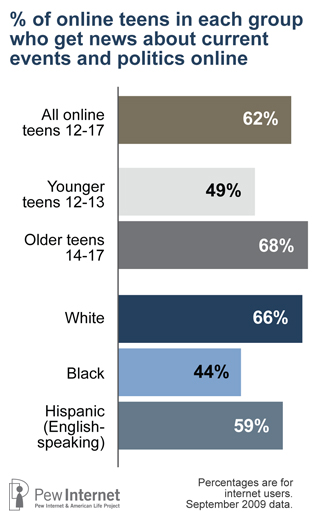
White teens and teens from families with higher income and education levels are more likely to report visiting sites for online news or political information. Two-thirds of online white teens (66%) say they have gone online to get news or information about current events or politics, while 44% of black teens and 59% of English-speaking Hispanic teens have done the same. Teens whose parents have a college degree or earn more than $75,000 annually are more likely than teens whose parents have a high school diploma or earn less than $50,000 in household income to seek out online information about politics or current events.
Previous Pew Internet studies have shown similar findings for online news use and household income and education and age. However, previous research did not show any racial or ethnic difference in online news use.
In Pew Internet surveys, adults are generally asked two separate items about getting news online and going online for news or information about politics. As of April 2009, 72% of online adults get news online, and as of December 2009, 68% of online adults get news or information online that is specifically about politics. The percentage of adult internet users who get news online has held fairly constant since 2002, when 71% of adult internet users reported getting news online. In contrast, getting political news online has increased dramatically since it was first measured by Pew Internet in March of 2000. At that time, just 35% of online adults were getting political news online.
Similar to teen news consumption behavior, as well as adults’ online shopping, educational attainment and income are both positively correlated with getting news online. Eight in ten college-educated adult internet users (81%) get news online; that figure drops to 59% among internet users who have not attended college. The same pattern holds when looking at online political news consumption; three in four college educated internet users (75%) get political news online, compared with just 56% of internet users with lower educational attainment.
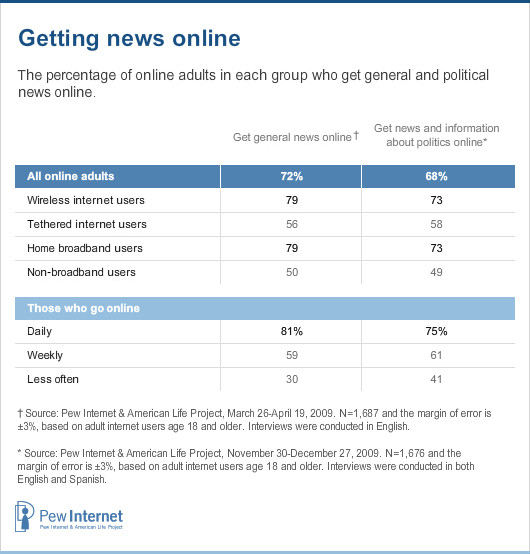
Wireless internet users are more likely than wired internet users to get both general news online (79% v. 56%) and to get political news online (73% v. 58%). Likewise, those with home broadband connections are more likely than other online adults to get general news (79% v. 50%) and political news (73% v. 49%) on the internet. Finally, those who go online daily are more likely than those who use the internet less frequently to get both general news and political news and information online.




